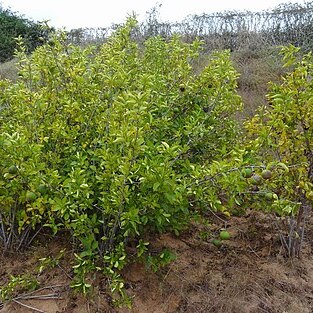Ovary 4-locular (or ?incompletely so); septa thinly membranous, adhering to the placentas; placentas 4, elongate, fleshy, attached at the apex to the style base; ovules numerous impressed on the placentas; style slightly swollen, glabrous; pollen presenter exserted, cylindrical, 2-winged, bifid at apex with each lobe emarginate.
Calyx 6–8-ribbed, covered with very short fleshy hairs when young, which soon erode to reveal a rather flaky corky underlayer; tube campanulate; limb entire in bud, acuminate, rupturing into 2–3 lobes at anthesis, densely covered with silky hairs with large interspersed colleters within.
Seeds numerous, embedded in pulpy placental tissue (see Bridson (1980) fig. 2C&D), sublenticular; testa very thin, finely rugulose; endosperm entire, horny; embryo straight.
Corolla tube short in proportion to the lobes, cylindrical to funnel-shaped; lobes 8–11, narrowly oblong, spreading, overlapping to the right in bud (as seen from outside).
Flowers precocious, hermaphrodite, solitary, terminal on short lateral branches (but may be exceeded by the development of an axillary branch), sessile, large.
Anthers 8–11, sessile, attached near the base, inserted at throat, exserted by ± two thirds the length of the corolla lobes, linear, shortly acuminate.
Leaves opposite, petiolate, papery, restricted to new growth at apex of branches; stipules ovate-triangular with colleters and silky hairs within.
Fruit large, globular, smooth, 1-locular (see Bridson (1980) fig. 2A&B), calyx limb caducous; pericarp thick.
Shrub or small tree; branches pubescent when young.
Pollen grains simple.
Disk annular.

